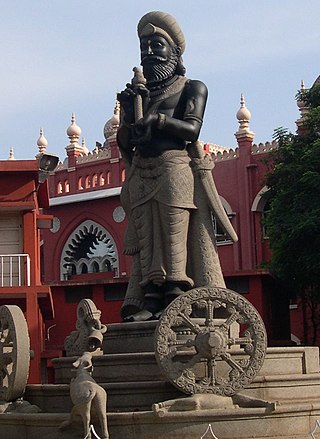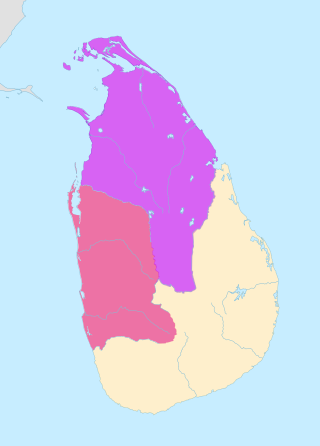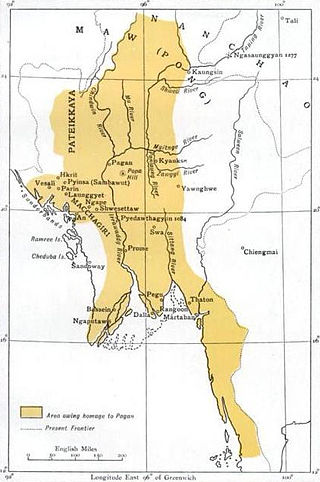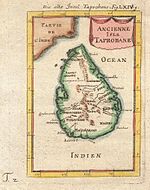
Poḷonnaruwa, also referred as Pulathisipura and Vijayarajapura in ancient times, is the main town of Polonnaruwa District in North Central Province, Sri Lanka. The modern town of Polonnaruwa is also known as New Town, and the other part of Polonnaruwa remains as the royal ancient city of the Kingdom of Polonnaruwa.

The Principality of Ruhuna, also referred to as the Kingdom of Ruhuna, is a region of present-day Southern and Eastern Sri Lanka. It was the center of a flourishing civilisation and the cultural and economic centres of ancient Sri Lanka. Magama, Tissamaharama and Mahanagakula were established here.

Ellalan was a member of the Tamil Chola dynasty in Southern India, also known as "Manu Needhi Cholan", who upon capturing the throne became king of the Anuradhapura Kingdom, in present-day Sri Lanka, from 205 BCE to 161 BCE.

Lilavati was the fourth woman in Sri Lankan history to rule as sovereign in her own right. Lilavati rose to prominence as the wife of Parakramabahu I, king of the Kingdom of Polonnaruwa. Being of royal descent herself, she then ruled as sole monarch on three occasions in the near-anarchy following Parakramabahu's death, with the backing of various generals. The primary source for her life is the Culavamsa, specifically chapter LXXX.
Kalinga Magha or Gangaraja Kalinga Vijayabahu was an invader from the Kingdom of Kalinga who usurped the throne from Parakrama Pandyan II of Polonnaruwa in 1215. A massive migration followed of Sinhalese people to the south and west of Sri Lanka, and into the mountainous interior, as they attempted to escape his power. Magha was the last ruler to have his seat in the traditional northern seat of native power on the island, known as Rajarata; so comprehensive was his destruction of Sinhalese power in the north that all of the successor kingdoms to Rajarata existed primarily in the south of the island.
The Chola military was the combined armed forces of the Chola Empire organized during two separate Tamil golden ages, the Sangam Period and the Medieval Era. The Chola military fought dozens of wars, it also underwent numerous changes in structure, organization, equipment and tactics, while conserving a core of lasting Tamil traditions.

Parākramabāhu I, or Parakramabahu the Great, was the king of Polonnaruwa from 1153 to 1186. He oversaw the expansion and beautification of his capital, constructed extensive irrigation systems, reorganised the country's army, reformed Buddhist practices, encouraged the arts and undertook military campaigns in South India and Burma. The adage, "Not even a drop of water that comes from the rain must flow into the ocean without being made useful to man" is one of his most famous utterances."

The Kingdom of Polonnaruwa was the Sinhalese kingdom that expanded across the island of Sri Lanka and several overseas territories, from 1070 until 1232. The kingdom started expanding its overseas authority during the reign of Parakramabahu the Great.

Vijayabahu I, also known as Vijayabahu the Great, was a medieval king of Sri Lanka. Born to a royal bloodline, Vijayabahu grew up under Chola occupation. He assumed rulership of the Ruhuna principality in the southern parts of the country in 1055. Following a seventeen-year-long campaign, he successfully drove the Cholas out of the island in 1070, reuniting the country for the first time in over a century. During his reign, he re-established Buddhism in Sri Lanka and repaired much of the damage caused to infrastructure during the wars. He offered the Thihoshin Pagoda(Lord of Sri Lanka Buddha image) to Burma king Alaungsithu and it is now still in Pakokku.

The current legislative capital of Sri Lanka is Sri Jayawardenepura Kotte and the executive and judicial capital is Colombo. Over the course of the island's history, the national capital has been in several locations other than Sri Jayawardenepura Kotte, the following is a list of cities which have historically served as the capital city of Sri Lanka and its predecessor states.

Nissanka Malla, also known as Keerti Nissanka and Kalinga Lokesvara was a king of Polonnaruwa who ruled the country from 1187 to 1196. He is known for his architectural constructions such as the Nissanka Lata Mandapaya, Hatadage and Rankot Vihara, as well as for the refurbishment of old temples and irrigation tanks.

The Anuradhapura period was a period in the history of Sri Lanka of the Anuradhapura Kingdom from 377 BCE to 1017 CE. The period begins when Pandukabhaya, King of Upatissa Nuwara moved the administration to Anuradhapura, becoming the kingdom's first monarch. Anuradhapura is heralded as an ancient cosmopolitan citadel with diverse populations.

The Chola conquest of Anuradhapura was a military invasion of the Kingdom of Anuradhapura by the Chola Empire. It can be seen as an ensuing conflict between Chola and Sinhalese kings after the initial conflict between Chola and the Pandya-Sinhalese alliance during conquest of the Pandya Kingdom by Chola king Parantaka I. After the defeat, Pandya king Rajasimha took his crown and the other regalia and sought refuge in Anuradhapura. The Paranthka made several futile attempts to regain regalia, including invasion of Sri Lanka on a date between 947 and 949 CE during the reign of Sinhalese king Udaya IV. Therefore, one of the driving motives behind the invasions of Anuradhapura by the Cholas' was their desire to possess these royal treasures. The conquest started with the invasion of the Anuradhapura Kingdom in 993 CE by Rajaraja I when he sent a large Chola army to conquer the kingdom and absorb it into the Chola Empire. Most of the island was subsequently conquered by 1017 CE and incorporated as a province of the vast Chola empire during the reign of his son Rajendra Chola I. The Chola occupation would be overthrown in 1070 CE through a campaign of Sinhalese Resistance led by Prince Kitti, a Sinhalese royal. The Cholas fought many subsequent wars and attempted to reconquer the Sinhalese kingdom as the Sinhalese were allies of their arch-enemies, the Pandyas. The period of Chola entrenchment in northern Sri Lanka lasted in total about three-quarters of a century, from roughly 993 CE to 1070 CE, when Vijayabahu I recaptured the north and expelled the Chola forces restoring Sinhalese sovereignty.

The Pandyan Civil War from 1169 to 1177 was precipitated by rival claims of succession to the Pandyan throne. The Civil War began between Parakrama Pandyan and his nephew Kulasekhara Pandyan and lasted for next 15 years between successive Pandyan kings. The war gradually spread to the rest of Southern India when the Chola King Rajadhiraja II and the Sinhalese King Parakramabahu I of Polonnaruwa entered the fray and took opposing sides in the conflict, eager to increase their influence in the Pandya kingdom.

Rajarata was one of three historical regions of the island of Sri Lanka for about 1,700 years from the 6th century BCE to the early 13th century CE. Several ancient cities, including Tambapanni, Upatissa Nuwara, Anuradhapura and Polonnaruwa, were established as capitals within the area by successive rulers. Rajarata was under the direct administration of the King. Two other areas, Mayarata and Ruhunurata, were ruled by the king's brothers "Mapa" and "Epa". The Magha invasion in the 13th century brought about the end of the Rajarata kingdom.

Parakramabahu II, also known as Panditha Parakramabāhu, was the King of Dambadeniya in 13th century, whose reign lasted from 1236 to 1270. As a pioneer in literature, he was bestowed with the honorary title "Kalikala Sahitya Sarvagna Pandita". Parakramabahu's reign is notable for the creation of numerous Sinhalese literal works such as, Kausilumina, Pūjāvaliya, Pāli Vishuddḥi Mārgaya, Thūpavaṃsa and Sidhath Sangarāva. He launched a campaign against the Eastern Ganga invader Kalinga Magha, and successfully expelled him in 1255, unifying Sri Lanka under one rule. He succeeded his father Vijayabahu III as King of Dambadeniya, and was succeeded by his elder son, Vijayabahu IV, after his death.

The Transitional period of Sri Lanka spans from the end of the Kingdom of Polonnaruwa, in 1232, to the start of the Kandyan period in 1597. The period is characterised by the succession of capitals that followed the fall of the Polonnaruwa Kingdom and the creation of the Jaffna kingdom and Crisis of the Sixteenth Century.

Polonnaruwa–Pagan War were a series of successful military expeditions led-by Sinhalese king Parakramabahu the Great against the Bagon Kingdom between 1165 and 1181. It occurred as a result of a trade dispute between the two states.














